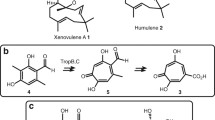Abstract
Ergot alkaloids are toxins and important pharmaceuticals which are produced biotechnologically on an industrial scale. A putative gene fgaDH has been identified in the biosynthetic gene cluster of fumigaclavine C, an ergot alkaloid of the clavine-type. The deduced gene product FgaDH comprises 261 amino acids with a molecular mass of about 27.8 kDa and contains the conserved motifs of classical short-chain dehydrogenases/reductases (SDRs), but shares no worth mentioning sequence similarity with SDRs and other known proteins. The coding region of fgaDH consisting of two exons was amplified by PCR from a cDNA library of Aspergillus fumigatus, cloned into pQE60 and overexpressed in E. coli. The soluble tetrameric His6-FgaDH was purified to apparent homogeneity and characterized biochemically. It has been shown that FgaDH catalyzes the oxidation of chanoclavine-I in the presence of NAD+ resulting in the formation of chanoclavine-I aldehyde, which was unequivocally identified by NMR and MS analyzes. Therefore, FgaDH functions as a chanoclavine-I dehydrogenase and represents a new group of short-chain dehydrogenases. K M values for chanoclavine-I and NAD+ were determined at 0.27 and 1.1 mM, respectively. The turnover number was 0.38 s−1.




Similar content being viewed by others
References
Coyle CM, Panaccione DG (2005) An ergot alkaloid biosynthesis gene and clustered hypothetical genes from Aspergillus fumigatus. Appl Environ Microbiol 71:3112–3118
de Groot AN, van Dongen PW, Vree TB et al (1998) Ergot alkaloids. Current status and review of clinical pharmacology and therapeutic use compared with other oxytocics in obstetrics and gynaecology. Drugs 56:523–535
Fleetwood DJ, Scott B, Lane GA et al (2007) A complex ergovaline gene cluster in epichloe endophytes of grasses. Appl Environ Microbiol 73:2571–2579
Flieger M, Wurst M, Shelby R (1997) Ergot alkaloids—sources, structures and analytical methods. Folia Microbiol (Praha) 42:3–30
Floss HG, Tscheng-Lin M, Chang C et al (1974) Biosynthesis of ergot alkaloids. Studies on the mechanism of the conversion of chanoclavine-I into tetracyclic ergolines. J Am Chem Soc 96:1898–1909
Gröger D, Floss HG (1998) Biochemistry of ergot alkaloids—achievements and challenges. Alkaloids Chem Biol 50:171–218
Haarmann T, Machado C, Lübbe Y et al (2005) The ergot alkaloid gene cluster in Claviceps purpurea: extension of the cluster sequence and intra species evolution. Phytochemistry 66:1312–1320
Haarmann T, Rolke Y, Giesbert S et al (2009) Ergot: from witchcraft to biotechnology. Mol Plant Pathol 10:563–577
Hassam SB, Floss HG (1981) Biosynthesis of ergot alkaloids. Incorporation of (17R)-(17–3H)- and (17S)-(17–3H) chanoclavine-I into elymoclavine by Claviceps. J Nat Prod 44:756–758
Jörnvall H (2008) Medium- and short-chain dehydrogenase/reductase gene and protein families: MDR and SDR gene and protein superfamilies. Cell Mol Life Sci 65:3873–3878
Kavanagh KL, Jornvall H, Persson B et al (2008) The SDR superfamily: functional and structural diversity within a family of metabolic and regulatory enzymes. Cell Mol Life Sci 65:3895–3906
Kren V, Pazoutova S, Sedmera P et al (1986) High-production mutant Claviceps purpurea 59 accumulating secoclavines. FEMS Microbiol Lett 37:31–34
Laemmli UK (1970) Cleavage of structural proteins during the assembly of the head of bacteriophage T4. Nature 227:680–685
Li S-M, Unsöld IA (2006) Post genome research on the biosynthesis of ergot alkaloids. Planta Med 72:1117–1120
Liu X, Wang L, Steffan N et al (2009) Ergot alkaloid biosynthesis in Aspergillus fumigatus: FgaAT catalyses the acetylation of fumigaclavine B. Chembiochem 10:2325–2328
Maier W, Erge D, Schmidt J et al (1980) A blocked mutant of Claviceps purpurea accumulating chanoclavine-I-aldehyde. Experientia 36:1353–1354
Naidoo B, Cassady JM, Blair GE et al. (1970) Biosynthesis of ergot alkaloids. Synthesis of chanoclavine-I-aldehyde and its incorporation into elymoclavine by Claviceps. J Chem Soc Chem Commun 471–472
Panaccione DG (2005) Origins and significance of ergot alkaloid diversity in fungi. FEMS Microbiol Lett 251:9–17
Rigbers O, Li S-M (2008) Ergot alkaloid biosynthesis in Aspergillus fumigatus: overproduction and biochemical characterisation of a 4-dimethylallyltryptophan N-methyltransferase. J Biol Chem 283:26859–26868
Sajdl P, Rehácek Z (1975) Cyclization of chanoclavine-I by cell-free preparations from saprophytic Claviceps strains. Folia Microbiol (Praha) 20:365–367
Sambrook J, Russell DW (2001) Molecular cloning: a laboratory manual, 3rd edn. Cold Spring Harbor Laboratory Press, New York
Schardl CL, Panaccione DG, Tudzynski P (2006) Ergot alkaloids—biology and molecular biology. Alkaloids Chem Biol 63:45–86
Stauffacher D, Tscherter H (1964) Isomere des Chanoclavines aus Claviceps purpurea (Fr.) TUL. (Secale cornutum). Helv Chim Acta 47:2186–2194
Steffan N, Grundmann A, Yin W-B et al (2009) Indole prenyltransferases from fungi: a new enzyme group with high potential for the production of prenylated indole derivatives. Curr Med Chem 16:218–231
Tsai HF, Wang H, Gebler JC et al (1995) The Claviceps purpurea gene encoding dimethylallyltryptophan synthase, the committed step for ergot alkaloid biosynthesis. Biochem Biophys Res Commun 216:119–125
Tudzynski P, Holter K, Correia T et al (1999) Evidence for an ergot alkaloid gene cluster in Claviceps purpurea. Mol Gen Genet 261:133–141
Unsöld IA, Li S-M (2005) Overproduction, purification and characterization of FgaPT2, a dimethylallyltryptophan synthase from Aspergillus fumigatus. Microbiology 151:1499–1505
Unsöld IA, Li S-M (2006) Reverse prenyltransferase in the biosynthesis of fumigaclavine C in Aspergillus fumigatus: gene expression, purification and characterization of fumigaclavine C synthase FgaPT1. Chembiochem 7:158–164
Acknowledgments
This work was supported by a grant from the Deutsche Forschungsgemeinschaft (to S.-M. Li).
Author information
Authors and Affiliations
Corresponding author
Additional information
Communicated by Erko Stackebrandt.
Rights and permissions
About this article
Cite this article
Wallwey, C., Matuschek, M. & Li, SM. Ergot alkaloid biosynthesis in Aspergillus fumigatus: conversion of chanoclavine-I to chanoclavine-I aldehyde catalyzed by a short-chain alcohol dehydrogenase FgaDH. Arch Microbiol 192, 127–134 (2010). https://doi.org/10.1007/s00203-009-0536-1
Received:
Revised:
Accepted:
Published:
Issue Date:
DOI: https://doi.org/10.1007/s00203-009-0536-1




